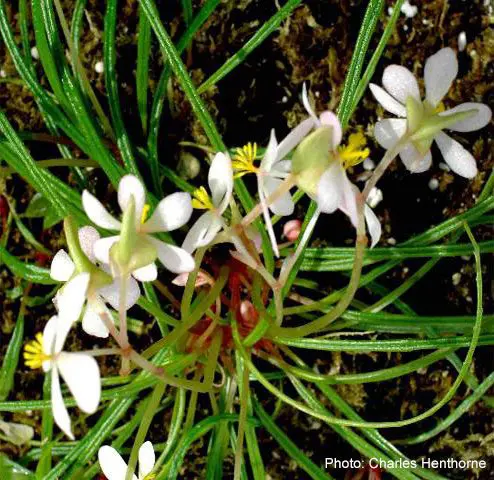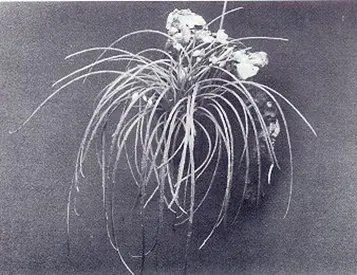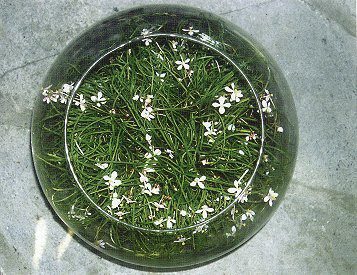Ann Salisbury in this issue writes about strolling through The Begonian pages of the past and the people you will meet. But there is also invaluable information about begonias there. I had been trying to get someone to write about B. bogneri to go with a photo taken by Janet Welsh in 6/04; this Begonia was also beautifully present at the San Diego Convention Show. But looking in an old Begonian, I found that the perfect article had already been written, more than 30 years ago, and it is as relevant today as then. I have taken excerpts below, but it is worth while to search out this edition of The Begonian and read the whole article.
A chance remark to Josef Bogner, inspector of the Munich botanical Garden, Germany, when I visited the garden in August 1969, that not half of the world’s Begonia species have yet been discovered and named, was the opening which gave me an opportunity to see a most unique Begonia which Mr. Bogner had recently discovered, and subsequently to grow, propagate, and now describe the new species.
Ann Salisbury in this issue writes about strolling through The Begonian pages of the past and the people you will meet. But there is also invaluable information about begonias there. I had been trying to get someone to write about B. bogneri to go with a photo taken by Janet Welsh in 6/04; this Begonia was also beautifully present at the San Diego Convention Show. But looking in an old Begonian, I found that the perfect article had already been written, more than 30 years ago, and it is as relevant today as then. I have taken excerpts below, but it is worth while to search out this edition of The Begonian and read the whole article.
A chance remark to Josef Bogner, inspector of the Munich botanical Garden, Germany, when I visited the garden in August 1969, that not half of the world’s Begonia species have yet been discovered and named, was the opening which gave me an opportunity to see a most unique Begonia which Mr. Bogner had recently discovered, and subsequently to grow, propagate, and now describe the new species.
The recent discovery of Begonia bogneri had occurred on January 23, 1969 in the Malagasy Republic (formerly Madagascar), while Mr. Bogner was visiting the very little explored mountainous Presqu’lle de Masoala in an area called Hiataka which has an average annual rainfall of about 3500 mm (140″) and a yearly average of 230 rainy days. He was looking for aroids but found at an elevation of about 50 meters (165′) in the deep shade of steep, mossy, granite cliffs the grasslike begone we are naming Begonia bogneri covering the naked rocks among mosses, ferns and sometimes Pothos scandens.The locality of this new species is very small, no larger than one hectare (2.471 acres); the mountains at Hiaraka arising from sea level immediately to about 1000 m. (3300′). Mr. Bogner climbed to the top but found no other place where the Begonia was growing.
Hiaraka can be reached only on foot or by boat and Mr. Bogner was brought there by motorboat from Maroantsetra, traversing the Baie d’Antongil, by Mr. A. Peyrieras, entomologist at ORSTOM (Office de la Recherche Scientifique et Technique Outre-mer) in Tananative.
Mr. Bogner collected living plants and herbarium specimens of the new Begonia under his number Bogner 261. Living plants were sent to three botanical gardens in Europe, but they survived only in Munich where the plant was propagated.
After Mr. Bogner sent me plants of this unusual Begonia, I studied the Begonia literature in order to determine whether it had already been described and named; it appears it has not.
I have grown this Begonia in a terrarium where the plant readily produced male flowers, but it was not until the plant was put under fluorescent lights indoors that a female flower appeared.
A study of the flowers placed the plant in Begonia section Erminea A. DC. Plants in this section have male flowers with four tepals and female flowers with six tepals. Begonia bogneri has an erect stem, a leafstalk which is not readily discernible, the dried leaf and its petiole being 9 cm (3 1 /2″) long and 1.5 mm (1/16″) wide. The leaf is essentially the same width its entire length, being strap-like in shape; the nerves are arranged like a feather, but the side nerves are not visible . …
The plant Mr. Bogner designated from the wilds as the type specimen is only 10.1 cm. (4″) tall. However I will first describe the plant as I know it in cultivation.
This plant is being named Begonia bogneri in honor of its discoverer. Its outstanding characteristics are its narrow and long leaves (Figure 1.) The leaves of the growing plant are about 2 mm. (1 /8″) wide and 15.2 cm. (6″) long, medium green with the upper surface shiny without any appendages. The leaf remains the same width its entire length; the tip comes quickly to a rounded point. Little pits appear here and there on the upper surface of the leaves (only visible by a lens.) That there is one nerve running the entire length of the leaf is easily observable because it is depressed into the leaf. No side veins are visible although a study of the cross section of the leaf does reveal lateral nerves each of which terminated in a little saw tooth. On the edge of the leaf . … When grown in the open greenhouse without artificial light, the plant has a dormant period of a plant which produces a swollen stem base . … The plant I received from Munich appeared at first to be stemless. With time the stem became visible, reaching by January 1973 a length of 3.1 cm.(1 1 /4″)….
To me B. bogneri is a most unusual plant and a valuable addition to any begonia collection. I like the plant as it is, but wonder what hyridizers will do with it.
Even the editor has been able to keep this little jewel alive so if you can find one, by all means try it!
I have found B. bogneri to be an excellent terrarium plant and under lights it has been evergreen. I have grown the plant in sphagnum moss, in a mixture of peat, vermiculite, pearlite and limestone, as well as in my regular soil mix, and have had good results. In my opinion the plant is most attractive grown in moss or fibrous peat on cork as a hanging plant as Mr. Bogner grows it as shown in the photograph. In cultivation the plant develops into a clump consisting of a number of stems all arising from the one tuberlike body . …
And a wonder to me is that if the tiny leaves, either whole or in part, are planted in moss, they eventually produce new plants!




